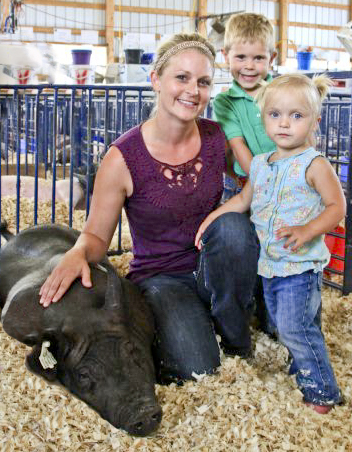Featured Farmer - Hannah Walkes
Posted: 9/27/2012
Never Say Never
Returning to her roots gives others the opportunity to do the same
In honor of October Pork Month, this month’s Featured Farmer profile is Hannah Walkes, who works to help the next generation of South Dakota pork producers build their futures on the farm.
Hannah grew up on a traditional corn and soybean farm in southwest Minnesota. Her family also raised pigs, cattle and sheep.
“Growing up on a fourth generation hog farm, I swore at a young age that I would never grow up to work with pigs … it was hard work,” said Hannah.
However, as she earned her college degree at South Dakota State University and conducted animal health and vaccine research, she was impressed with the improvements in caring for and handling pigs that made it better for both animals and the farmers who cared for them.
“As the industry developed safer practices and more farmer and animal-friendly facilities, I ventured back to my roots. I wouldn’t have it any other way,” she said.
For the past five years, Hannah has combined her background in animal health with a passion for helping family farmers succeed. As a swine specialist with the Pipestone System, she uses her education experience in microbiology and infectious diseases to help farmers address their animals’ health challenges and to promote animal well-being and food safety.
The Pipestone System is a group with a unique model that helps individual family farmers form groups to build hog barns and own the pigs housed in them.
“The owners of Pipestone System barns are family farmers with a stake in the communities surrounding the barns,” said Hannah. “Our goals are to be able to keep family farms independent and sustainable to allow future generations to come home.”
She said that adding a livestock component to a farm operation can be a good option for diversifying and bringing in new family members. Pigs provide an additional revenue stream, increase sustainability and allow for additional family members to be able to return to the farm and carry on the family legacy.
“With three brothers who all had a desire to return to the farm, I have seen firsthand how difficult it can be to bring in additional family members into a farming operation,” said Hannah. “Rising land, machinery and input costs make it very difficult.”
There are about 200 independent family farms involved in the Pipestone System producing about four million pigs each year. State-of-the art barns and management practices help keep pigs healthy and produce a nutritious food supply.
The group investment also allows farmers to take advantage of economies of scale they couldn’t on their own, said Hannah. Farmers can receive volume discounts for feed, animal health, and other services, which can quickly make a difference in the bottom line. In addition, many farmers feed the corn they produce to their pigs; and manure from the hog barns is applied as fertilizer to cropland.
Hannah works with independent pork producers in five states to help them monitor and maintain the health of their pig herd. She works to ensure that Pipestone’s commitment to ethical treatment of animals is carried out in all barns.
She also brings another important perspective to her job: being a mom. Hannah, her husband Dominic, and their two children live in Brandon, South Dakota. Their son Caden is five, and daughter Logan is two.
“Today’s South Dakota pork is the safest in the world. As a mother with young children, that is important to me and my family,” she said.
Modern hog barns have helped eliminate food pathogens that once plagued the industry. Raising animals indoors provides a climate controlled environment even in the harshest of South Dakota weather conditions, while keeping the pigs safe from predators and providing them with a constant, well-balanced diet.
Hannah is excited about the future of pork production in South Dakota, both for the farmers who raise it and the families who enjoy healthy, safe pork products at their dinner (and lunch, and breakfast) tables.
NOTE: This article also appears in the October issue of etc. for her

Comments
blog comments powered by Disqus